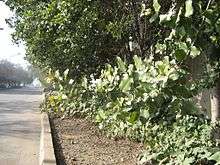Cryptocarya
| Cryptocarya | |
|---|---|
| | |
| Scientific classification | |
| Kingdom: | Plantae |
| (unranked): | Angiosperms |
| (unranked): | Magnoliids |
| Order: | Laurales |
| Family: | Lauraceae |
| Genus: | Cryptocarya R.Br. |
| Species | |
|
over 350; see text | |
| Synonyms | |


Cryptocarya is a genus of evergreen trees belonging to the laurel family, Lauraceae. The genus includes more than 350 species, distributed through the Neotropic, Afrotropic, Indomalaya, and Australasia ecozones.
Overview
The genus includes species of evergreen trees, distributed mostly in tropical and subtropical regions of South America, Mauritius, India, China, Java, New Guinea, and Africa, seven species in Southern Africa.
Common in the canopy, they grow up to 60 m, or as subcanopy trees in the succession climax species in tropical, lower temperate, or subtropical broadleaved forests. They are found in low-elevation evergreen forests and littoral rainforests, on all type of soils. The seeds are readily dispersed by fruit-eating birds, and seedlings and saplings have been recorded from other habitats where they are unlikely to develop to maturity.
The genus name Cryptocarya is from a Greek word krypto meaning to hide, karya meaning a walnut tree, the fruit of which was known as karyon', a word also used to describe other fruits. Sometimes, they are called mountain laurels or mountain walnuts. The fruit are succulent, partially immersed in a deep, thick cup.
In a recent generic classification of Lauraceae based on DNA sequence,[1] Cryptocarya was found to be part of a strongly supported clade that also includes Beilschmiedia, Potameia, Endiandra and Aspidostemon.[2]
Ecology
The ecological requirements of the genus are those of the laurel forest, mostly from the tropics or warmer temperate areas, and like most of their counterparts laurifolia in the world, they are vigorous species with a great ability to populate conducive habitats. The natural habitat of most of species are in rainforest which are cloud-covered for much of the year. These species are found in forests that face threats of destruction by human deforestation. Some species are in danger of extinction due to loss of habitat. Cryptocarya is a genus of great ecological importance. It is present in low rainforest and montane rainforest, laurel forest, in the weed-tree forests in valleys, and mixed forests of coniferous and deciduous broad-leaved trees. The differences are ecological adaptations to different environments over a relatively dry-wet and a warmer to mild frost (-2°C) in temperate climate growing in cooler regions, subject to frost and occasional snow. Species in less-humid environments are smaller or less robust, with less abundant and thinner foliage and have oleifera cells that give trees a more fragrant aroma. The most known trees are used by the timber industry. In this genus, the wood of some species has high commercial value.
The species forming this genus share a unique paniculate inflorescence with the ultimate divisions that are not quite cymose; that is, the lateral flowers of what looks like a cyme are not strictly opposite, but tend to be subopposite, while in most genera of Lauraceae with paniculate inflorescences the lateral flowers in a cyme are strictly opposite.
Cryptocarya has always been considered closely related to Ravensara, and is also related to the Beilschmiedia' clade and that, based on the presence of fruit included in the enlarged hypanthium, it is yet most closely related to Aspidostemon, through the similarity in fruit structure; in both Aspidostemon and Cryptocarya, the fruit are enclosed in the enlarged hypanthium, but this might be a parallel development and not a signal of common ancestry. The fruit, a drupe, is an important food source for birds, usually from specialized genera. Birds eat the whole fruit and regurgitate seeds intact, expanding the seeds in the best conditions for germination (ornitochory). In some species, seed dispersal is carried out by mammals.
Human use
Commercial selected species
The Chilean Cryptocarya alba and the Australian C. erythroxylon and C. foveolata of the mountains of New South Wales are outstanding for their frost tolerance within a genus having its majority of species growing in tropical climate. Cryptocarya woodii flowers in November with small inconspicuous flowers. These small flowers develop into round, shiny, purple-black fruits. This tree has a very hard brown wood. C. alba, the peumo, the most common evergreen tree in the Chilean Matorral ecoregion of central Chile, produces edible reddish fruits and is the most known species in the Northern Hemisphere. C. massoy is used commercially to produce essential oils. C. woodii leaves have been found in prehistoric settlements in Africa and are believed to have been used for insect control.[3]
Some Cryptocarya species
- C. acuminata
- C. alba - peumo (Chile)
- C. angulata - ivory laurel (Australia)
- C. aristata
- C. ashersoniana (Brazil)
- C. chinensis
- C. chingii
- C. cinnamomifolia (Australia)
- C. concinna
- C. corrugata
- C. crassinervia (Indonesia)
- C. cunninghamiana - Cunningham’s laurel (Australia)
- C. densiflora (Indonesia)
- C. erythroxylon - pigeonberry ash (southeast Australia)
- C. ferrarsii
- C. ferrea
- C. foetida - stinking laurel (Australia) -vulnerable
- C. foveolata - mountain walnut (southeast Australia)
- C. gigantocarpa
- C. glaucescens - jackwood (Australia)
- C. grandis Cinnamon Laurel (Australia)
- C. gregsonii (Lord Howe Island)
- C. hypospodia (Australia)
- C. invasorium
- C. laevigata - glossy laurel (Australia)
- C. leptospermoides
- C. mackinnoniana - rusty laurel (Australia)
- C. massoy (Indonesia)
- C. meissneriana (Australia)
- C. membranaceae
- C. micrantha Meisn. (Brazil)
- C. microneura - murrogun (Australia)
- C. moschata Nees et Mart. ex Nees (Brazil)
- C. multipaniculata
- C. murrayi - Murray’s laurel (Australia)
- C. natalensis = Dahlgrenodendron natalense (South Africa)
- C. nigra (Indonesia)
- C. nitens (Indonesia)
- C. oblata
- C. obovata (Australia)
- C. obtusifolia
- C. odorata
- C. onoprienkoana - rose maple (Queensland)
- C. palawanensis (Philippines) - endangered
- C. palmerstonii syn. Endiandra palmerstonii - Queensland walnut (Queensland)
- C. pleurosperma - poison walnut (Australia) - toxic and corrosive sap
- C. pluricostata
- C. rigida - rose maple (Australia)
- C. scortechinii (Indonesia)
- C. transversa
- C. tomentosa
- C. triplinervis - brown laurel (Australia)
- C. vulgaris
- C. wightiana
- C. williwilliana - small-leaved laurel (Australia)
- C. woodii
- This list is incomplete; you can help by expanding it.
References
External links
- Pictures of Cryptocarya alba or Peumo in Chile.